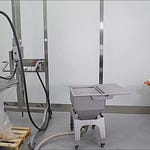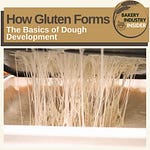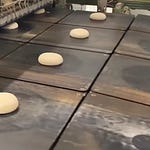Consumers tend to avoid chemical-sounding additives (like bromate, ADA, SSL, etc.), which is making bakeries increasingly turn to enzymes as natural dough conditioners and shelf-life extenders to create clean-label breads, using enzyme solutions that strengthen the dough, enhance fermentation, and delay staling.
Key Clean-Label Benefits of Enzyme Dough Improvers:
Gluten Strengthening: Enzymes like oxidases reinforce the gluten network, leading to stronger dough structure and higher loaf volume. This helps dough tolerate mechanization and hold gas better.
Fermentation Enhancement: Starch-degrading enzymes provide extra fermentable sugars, fueling yeast activity for faster fermentation, better oven spring, and improved volume. They can also standardize flour performance for consistent fermentation.
Natural Anti-Staling: Enzymes like maltogenic amylase slow down starch retrogradation (staling), keeping the crumb softer for longer. By retaining moisture in the starch gel, they extend bread’s fresh-eating quality and shelf life.
Replacing Additives: Modern enzyme solutions allow bakers to eliminate synthetic dough conditioners. For example, lipase can replace emulsifiers like DATEM/SSL, and glucose oxidase can substitute chemical oxidizers such as ADA. This yields cleaner labels while maintaining dough strength and freshness.
Amylases – Natural Fermentation Boosters & Crumb Softeners
During mixing and proofing, amylases break down starch into dextrins and maltose, providing fermentable sugars that accelerate yeast fermentation and boost CO₂ production.
They enhance oven spring and loaf volume, especially when flour enzyme levels are low.
Maltogenic amylases modify starch during baking to delay staling, keeping the crumb soft for longer. They slow starch retrogradation by trimming amylopectin chains into smaller dextrins, hindering their ability to recrystallize and firm the crumb.
They naturally replace chemical crumb softeners, allowing for clean-label shelf-life extension.
Xylanases (hemicellulases) – Enhancing Dough Structure and Volume
They target arabinoxylan fibers in wheat flour:
They break down fibers that trap water, releasing it for better gluten hydration.
The result is stronger, more extensible dough that retains gas effectively.
Improved gas retention leads to higher loaf volume and better oven spring.
Xylanase also enhances machinability, making dough easier to handle in high-speed production.
Proteases – Natural Dough Relaxers
In controlled doses, they hydrolyze gluten proteins, breaking peptide bonds to relax tight dough and improve extensibility. This action reduces elasticity, makes the dough easier to shape, and can shorten mixing time in industrial processes.
Useful for strong flours or flatbreads where reduced elasticity is desirable.
They can replace chemical reducing agents like L-cysteine, sodium metabisulfite, and similar dough softeners for clean-label dough softening.
Glucose Oxidase – Clean-Label Dough Strengthener
It oxidizes glucose to produce hydrogen peroxide in the dough:
The peroxide promotes cross-linking in gluten proteins, reinforcing the dough network by forming new disulfide bonds between protein chains.
These extra bonds tighten and stabilize the gluten structure, improve gas retention and overall dough strength, and lead to better dough stability and higher loaf volume.
It replaces chemical oxidizers such as ADA or bromate, aligning with clean-label expectations.
Lipases – Natural Emulsifier Replacers
They hydrolyze triglycerides and phospholipids, releasing mono- and diglycerides and lyso-phospholipids.
These byproducts function as natural emulsifiers, strengthening the gluten network and improving crumb softness.
Lipases replace chemical emulsifiers such as DATEM or SSL, supporting clean-label formulations.
They can also contribute to anti-staling, since generated emulsifiers can complex with starch and slow retrogradation.
In summary, enzyme blends that combine amylase, xylanase, lipase, and glucose oxidase deliver multi-functional improvements and are inactivated during baking, leaving no residue and supporting a clean ingredient list.
👉 Thanks for reading! 💬 Any experiences to share with us?? – We’d love to hear your story!











